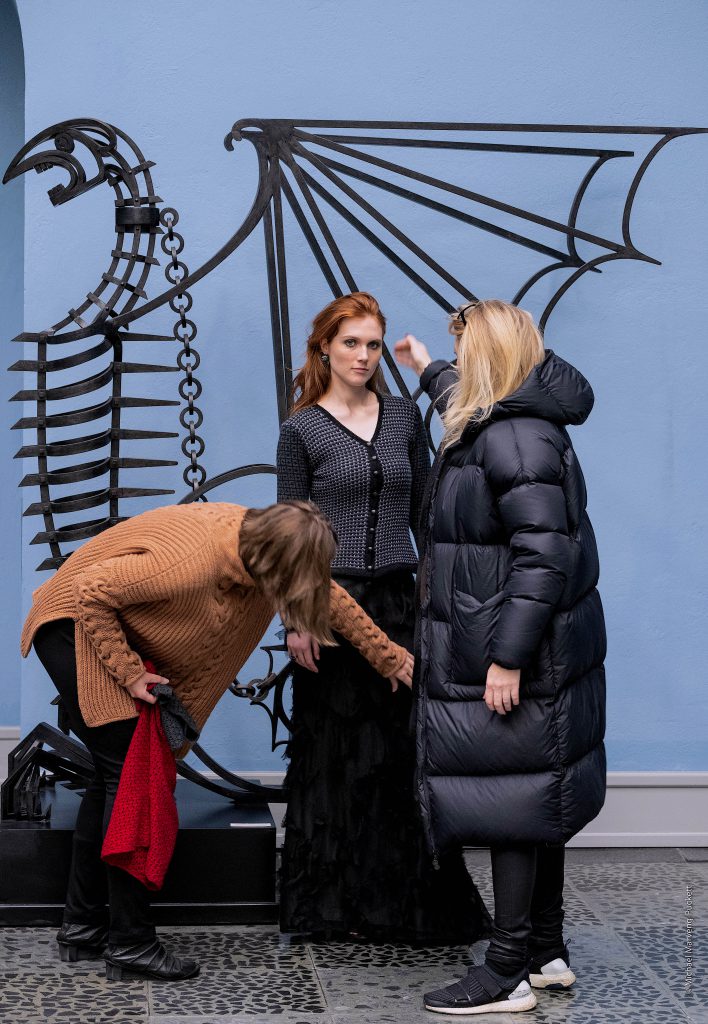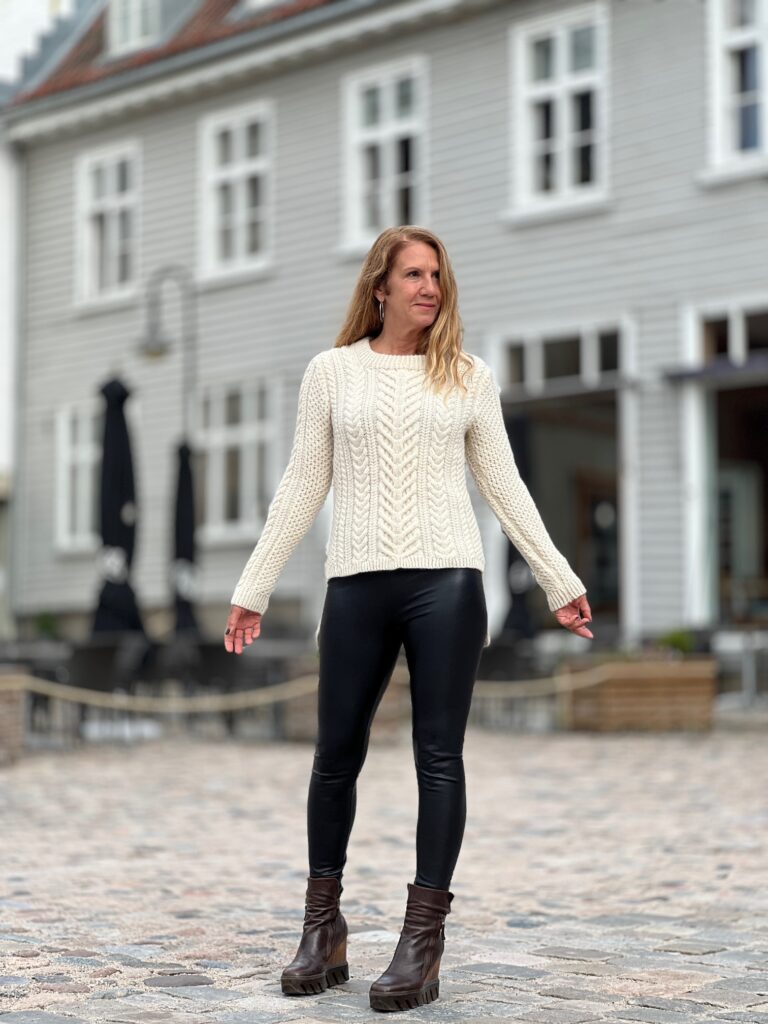 I am so thrilled to show you yet another brilliant set of photos of my old Nemetona design worn by my stunning friend Rebekah Audic, photographed by her husband Gael Audic in the old city of Fredrikstad. Continue reading
I am so thrilled to show you yet another brilliant set of photos of my old Nemetona design worn by my stunning friend Rebekah Audic, photographed by her husband Gael Audic in the old city of Fredrikstad. Continue reading
Tag Archives: The Fibre Co. Cumbria
Survey with Yarn & Pattern Prizes

Photoshoot at Mortensrud Church: Grian
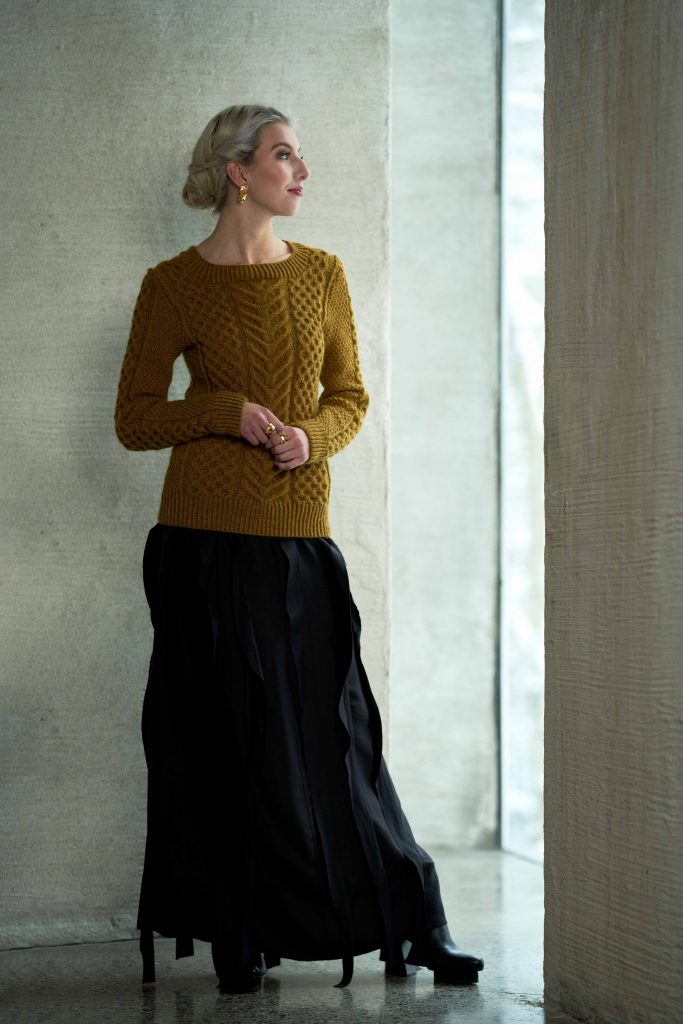 Model Olivia Lindtein looked fantastic in my fitted Grian pullover, with make-up & hair by Erica Poppe and jewellery by Kaja Gjedebo Design, over a silk skirt photographed by Eivind Røhne at Mortensrud Church back in November last year. After photographing the four Hillesvåg Ullvarefabrikk designs by the side wall, we moved to the second location inside the church, next to the small altar at the back, in the floor to ceiling window corner facing the pine trees on the crest of a hill where the church is located. As always, I wanted some full length photos but since this corner has a low ceiling the amount of daylight shining in was fading quickly.
Model Olivia Lindtein looked fantastic in my fitted Grian pullover, with make-up & hair by Erica Poppe and jewellery by Kaja Gjedebo Design, over a silk skirt photographed by Eivind Røhne at Mortensrud Church back in November last year. After photographing the four Hillesvåg Ullvarefabrikk designs by the side wall, we moved to the second location inside the church, next to the small altar at the back, in the floor to ceiling window corner facing the pine trees on the crest of a hill where the church is located. As always, I wanted some full length photos but since this corner has a low ceiling the amount of daylight shining in was fading quickly.
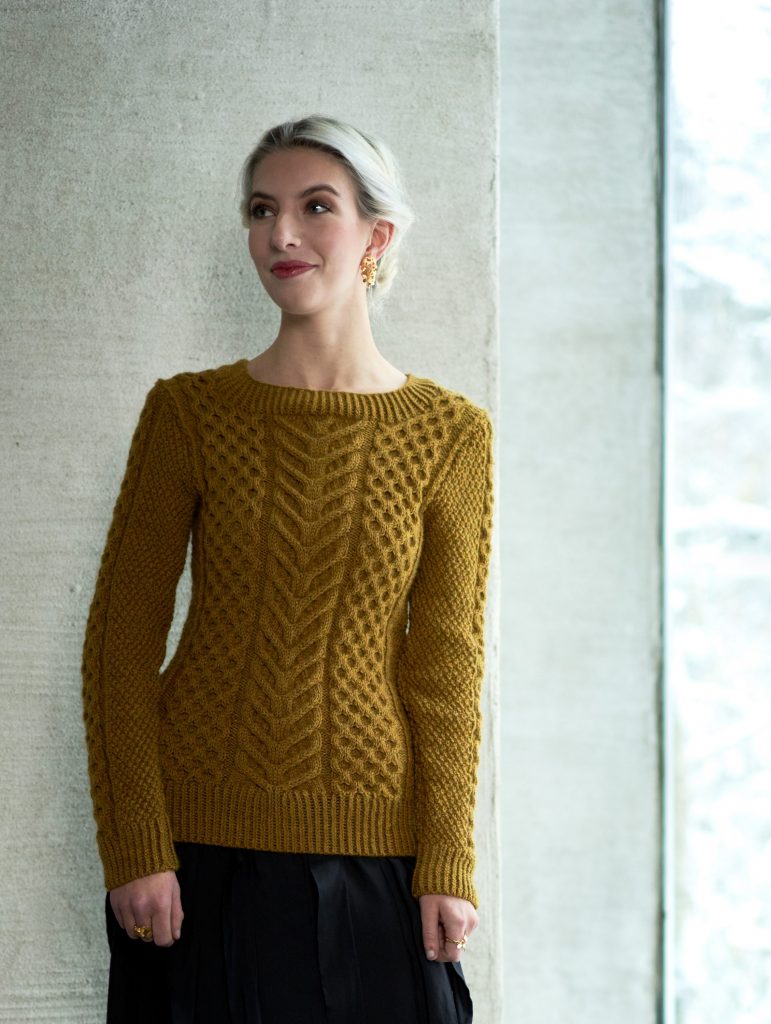 Named after the Faery Goddess from County Tipperary, is this pullover with heavy cabled texture. Grian means sunny, from her days as a regional sun deity, perfectly suited for this pullover. Honeycomb and stag horn cables adorn the body, while only honeycomb rule on the sleeves. Grian is slightly fitted with a crew neck and has a high cowl as a collar. The Fibre Co. Cumbria make the cables pop and allow the texture to shine in all its glory.
Named after the Faery Goddess from County Tipperary, is this pullover with heavy cabled texture. Grian means sunny, from her days as a regional sun deity, perfectly suited for this pullover. Honeycomb and stag horn cables adorn the body, while only honeycomb rule on the sleeves. Grian is slightly fitted with a crew neck and has a high cowl as a collar. The Fibre Co. Cumbria make the cables pop and allow the texture to shine in all its glory.
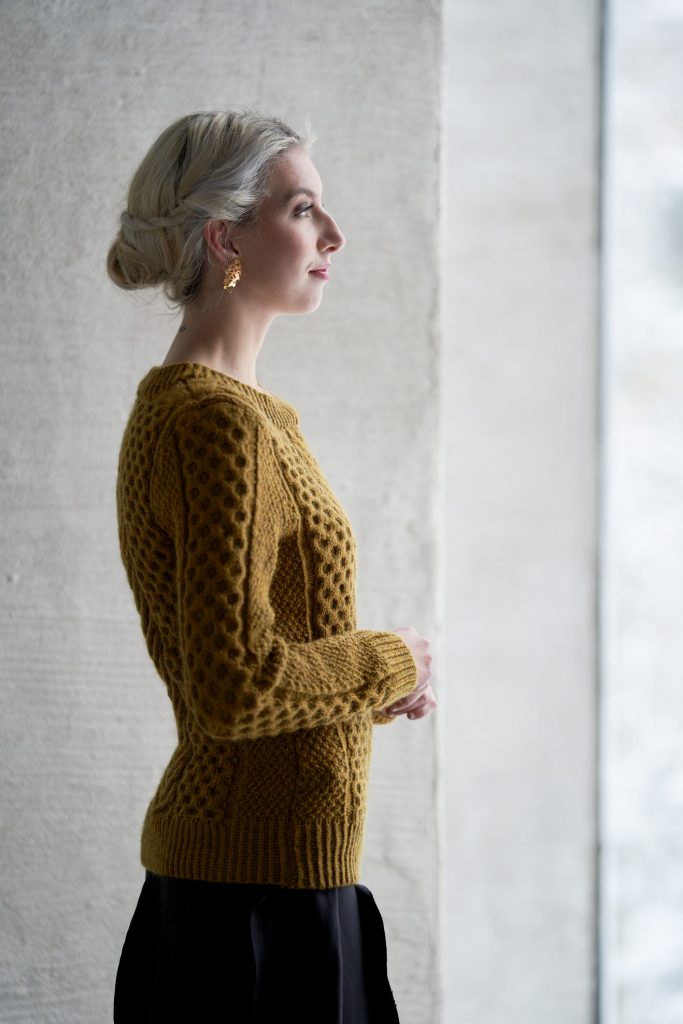 I knitted the sample in size Small with a 92 cm/36.25″ and worn with + 9 cm/3.5″ ease on Olivia, but I have graded the pattern from sizes XS to 5XL with a bust circumference of 84 to 158 cm/33 to 62.25″. The waist circumference is from 78 to 152 cm/30.75 to 59.75″.
I knitted the sample in size Small with a 92 cm/36.25″ and worn with + 9 cm/3.5″ ease on Olivia, but I have graded the pattern from sizes XS to 5XL with a bust circumference of 84 to 158 cm/33 to 62.25″. The waist circumference is from 78 to 152 cm/30.75 to 59.75″.
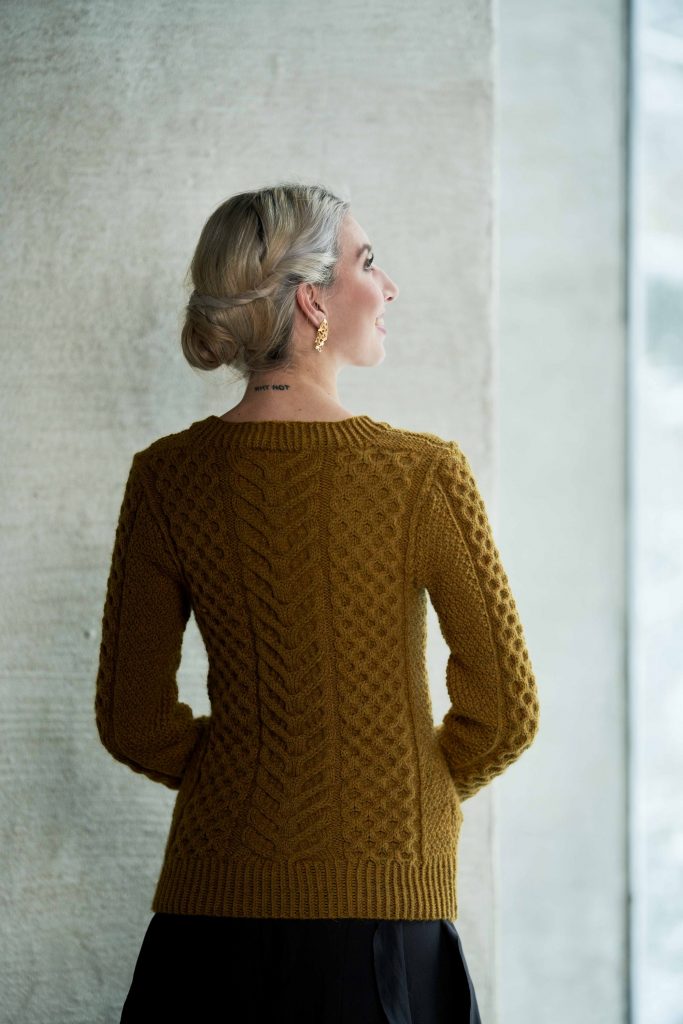 Grian is knitted in the divine The Fibre Co. Cumbria made of 60% merino wool, 30% masham wool, 10% mohair, with 218 meters/238 yards on each 100 gram skein. The sample is knitted in the new and lovely Threlkeld shade using 4 mm/US 6 needles and a 20 stitch and 28 stitches in stockinette stitch gauge. I received sponsored yarn for this design.
Grian is knitted in the divine The Fibre Co. Cumbria made of 60% merino wool, 30% masham wool, 10% mohair, with 218 meters/238 yards on each 100 gram skein. The sample is knitted in the new and lovely Threlkeld shade using 4 mm/US 6 needles and a 20 stitch and 28 stitches in stockinette stitch gauge. I received sponsored yarn for this design.
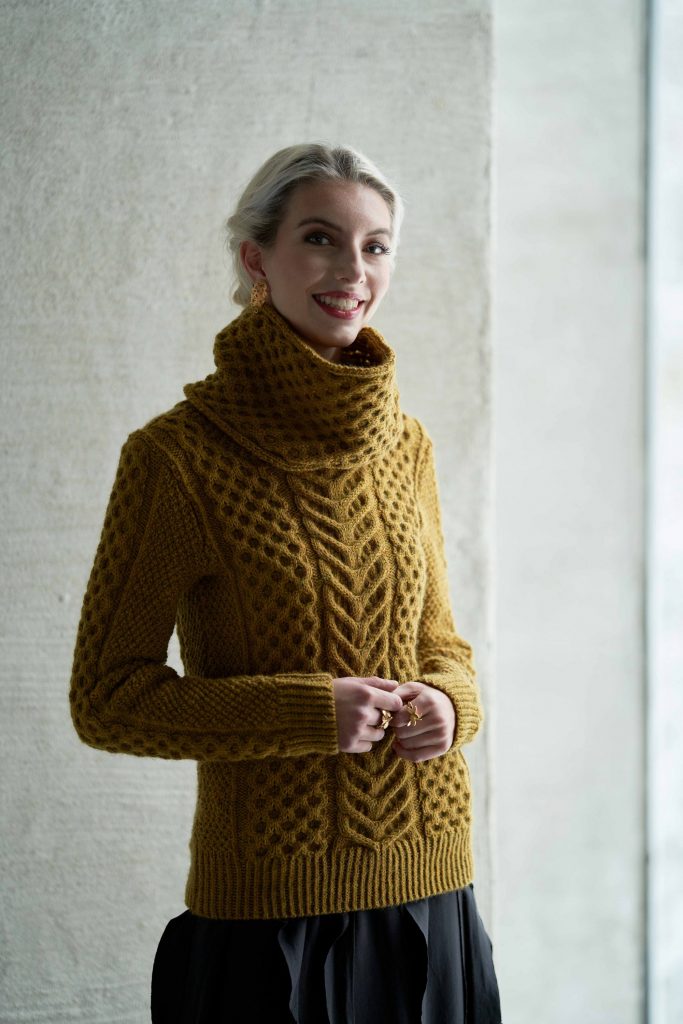 The cowl is 62 cm/24.5″ wide and 20 cm/8″ high. The pullover is worked back and forth in separate pieces and seamed. The cowl is also worked back and forth ending in a an I-cord bind off on both sides.
The cowl is 62 cm/24.5″ wide and 20 cm/8″ high. The pullover is worked back and forth in separate pieces and seamed. The cowl is also worked back and forth ending in a an I-cord bind off on both sides.
 The English pattern of Grian will be test knitted beginning on 20th of April in my Ravelry group before its release, while the Norwegian pattern will be printed in the magazine Familien at a later date.
The English pattern of Grian will be test knitted beginning on 20th of April in my Ravelry group before its release, while the Norwegian pattern will be printed in the magazine Familien at a later date.
Grian Size Range
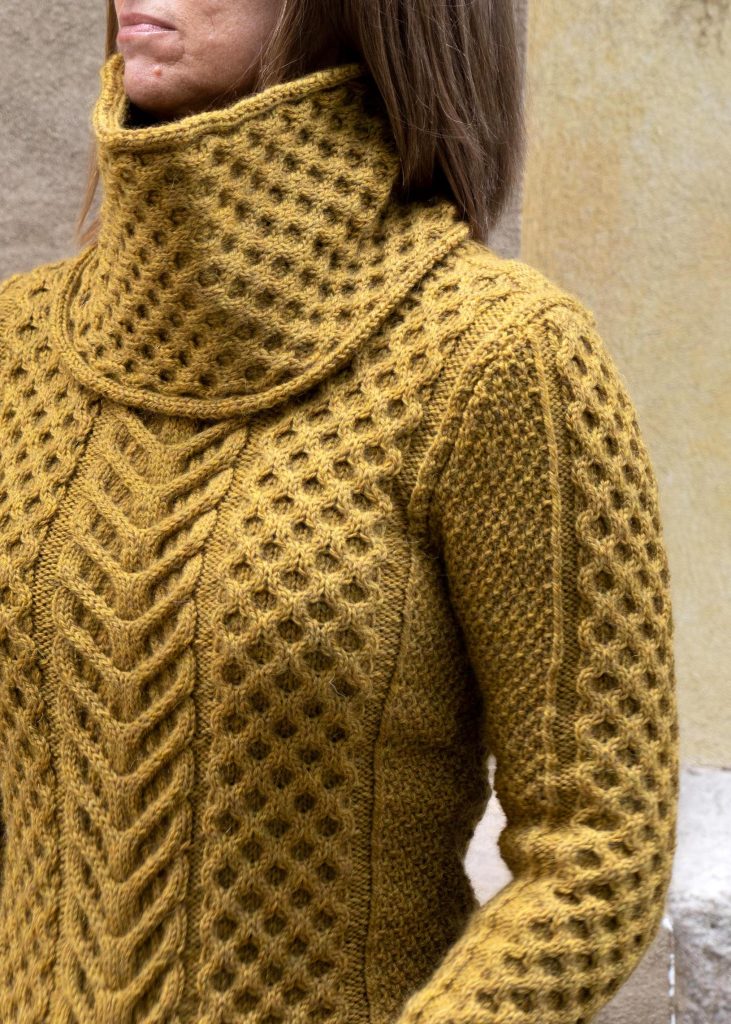 I received a number of requests for larger sizes in my new design Grian, so I decided to add two more sizes – 4XL and 5XL with 148 and 158 cm/58.25 and 62.25″ bust/hip circumference – to be more size inclusive; from size XS to 5XL. When I began looking at my measurements I also decided to alter size 3XL slightly, to even out the sizes a bit more. Hence my new Grian pullover pattern will be available in sizes XS to 5XL when it is released, after test knitting in my Ravelry group, which begins on the 20th of April. I am looking for more test knitters, especially in the larger sizes, so if you are interested please send me a message on Ravelry, where you will find me as lindamarveng. I have sent the pattern back to my technical editor Barbara Khouri for checking. Just to let you know, I do not plan to add those larger sizes to my excisting patterns, but will add them to new ones I am in the process of making. Above you see a close up of a photo Michael took of me wearing the sample in size Small. I look forward to showing you how fabulous it looks on Olivia. Below follows the pattern details with the new measurements, for more photos see the Grian project page.
I received a number of requests for larger sizes in my new design Grian, so I decided to add two more sizes – 4XL and 5XL with 148 and 158 cm/58.25 and 62.25″ bust/hip circumference – to be more size inclusive; from size XS to 5XL. When I began looking at my measurements I also decided to alter size 3XL slightly, to even out the sizes a bit more. Hence my new Grian pullover pattern will be available in sizes XS to 5XL when it is released, after test knitting in my Ravelry group, which begins on the 20th of April. I am looking for more test knitters, especially in the larger sizes, so if you are interested please send me a message on Ravelry, where you will find me as lindamarveng. I have sent the pattern back to my technical editor Barbara Khouri for checking. Just to let you know, I do not plan to add those larger sizes to my excisting patterns, but will add them to new ones I am in the process of making. Above you see a close up of a photo Michael took of me wearing the sample in size Small. I look forward to showing you how fabulous it looks on Olivia. Below follows the pattern details with the new measurements, for more photos see the Grian project page.
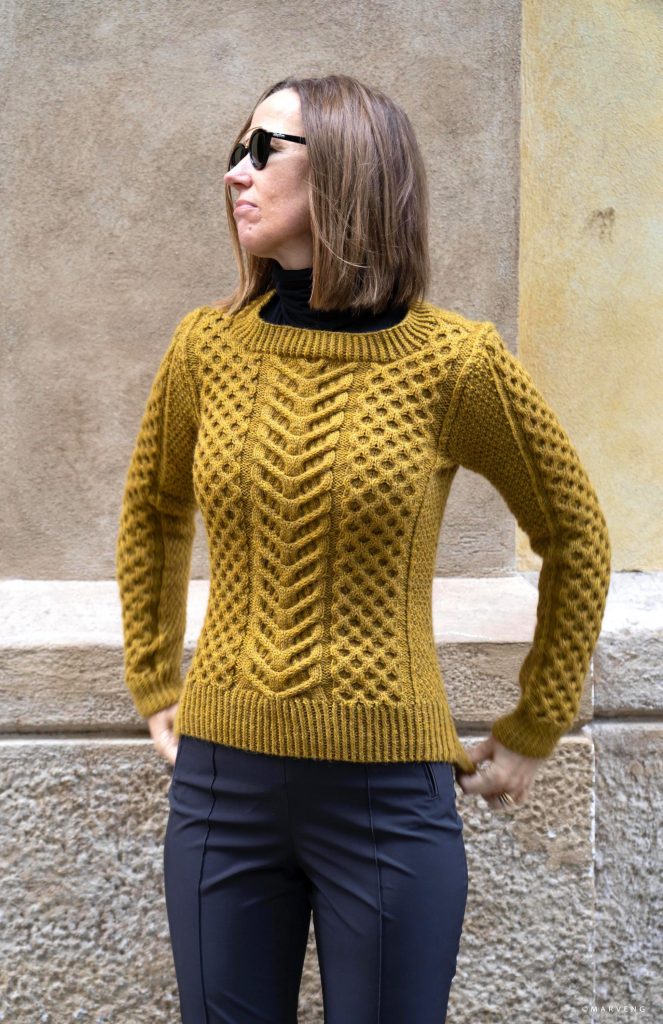 Named after the Faery Goddess from County Tipperary, is this pullover with heavy cabled texture. Grian means sunny, from her days as a regional sun deity, perfectly suited for this pullover. Honeycomb and stag horn cables adorn the body, while only honeycomb rule on the sleeves. Grian is slightly fitted with a crew neck and has a high cowl as a collar. The Fibre Co. Cumbria make the cables pop and allow the texture to shine in all its glory.
Named after the Faery Goddess from County Tipperary, is this pullover with heavy cabled texture. Grian means sunny, from her days as a regional sun deity, perfectly suited for this pullover. Honeycomb and stag horn cables adorn the body, while only honeycomb rule on the sleeves. Grian is slightly fitted with a crew neck and has a high cowl as a collar. The Fibre Co. Cumbria make the cables pop and allow the texture to shine in all its glory.
Sizes: XS (S, M, L, XL, 2XL, 3XL, 4XL, 5XL)
Shown in size Small.
Skill level: Experienced.
Finished measurements:
Bust/hip: 84 (92, 100, 108, 116, 124, 136, 148, 158) cm/33 (36.25, 39.25, 42.5, 45.75, 48.75, 53.5, 58.25, 62.25)“
Waist: 78 (86, 94, 102, 110, 118, 130, 142, 152) cm/30.75 (33.75, 37, 40.25, 43.25, 46.5, 51.25, 56, 59.75)”
Length: 61 (62, 63, 64, 65, 66, 67, 68, 69) cm/24 (24.5, 24.75, 25.25, 25.5, 26, 26.5, 26.75, 27.25)“
Sleeve length: 48 (49, 49, 49, 50, 50, 50, 50, 50) cm/19 (19.25, 19.25, 19.25, 19.75, 19.75, 19.75, 19.75, 19.75, 19.75, 19.75)”
Cowl: 62 cm/24.5 wide and 20 cm/8” high
Intended ease: + 5-7 cm/2-2.75”. Sample shown is 92 cm/36.25” and worn with + 9 cm/3.5” ease on model.
Yarn: The Fibre Co. Cumbria (60% merino wool, 30% masham wool, 10% mohair, 100 g, 218 m/238 yds). Sample is knitted in Threlkeld:
Pullover: 5 (6, 6, 7, 8, 8, 8, 9, 9) skeins; 1079 (1177, 1275, 1375, 1474, 1574, 1694, 1814, 1934) m/1180 (1287, 1394, 1504, 1612, 1721, 1852, 1984, 2115) yds.
Cowl: 1 skein; 207 m/226 yds.
https://www.thefibreco.com/product/cumbria/
Needles: 4 mm/US 6 straight needles and circular needle (40 cm/16”) for neckband.
Notions: Stitch markers, stitch holders and yarn needle.
Gauge: 20 sts and 28 rows using 4 mm/US 6 needle in st st measures 10 cm/4” square after blocking.
30-sts Staghorn cable measures 10 cm/4” wide after blocking.
24-sts Honeycomb measures 9 cm/3.5” wide after blocking.
Notes: The pullover is worked back and forth in separate pieces and seamed.
New Design: Grian
 The next and the last in the series of new designs is Grian made in The Fibre Co. Cumbria in their new colour Threlkeld. Named after the Faery Goddess from County Tipperary, is this pullover with heavy cabled texture. Grian means sunny, from her days as a regional sun deity, perfectly suited for this pullover. Honeycomb and stag horn cables adorn the body, while only honeycomb rule on the sleeves. Grian is slightly fitted with a crew neck and has a high cowl as a collar. The Fibre Co. Cumbria make the cables pop and allow the texture to shine in all its glory.
The next and the last in the series of new designs is Grian made in The Fibre Co. Cumbria in their new colour Threlkeld. Named after the Faery Goddess from County Tipperary, is this pullover with heavy cabled texture. Grian means sunny, from her days as a regional sun deity, perfectly suited for this pullover. Honeycomb and stag horn cables adorn the body, while only honeycomb rule on the sleeves. Grian is slightly fitted with a crew neck and has a high cowl as a collar. The Fibre Co. Cumbria make the cables pop and allow the texture to shine in all its glory.
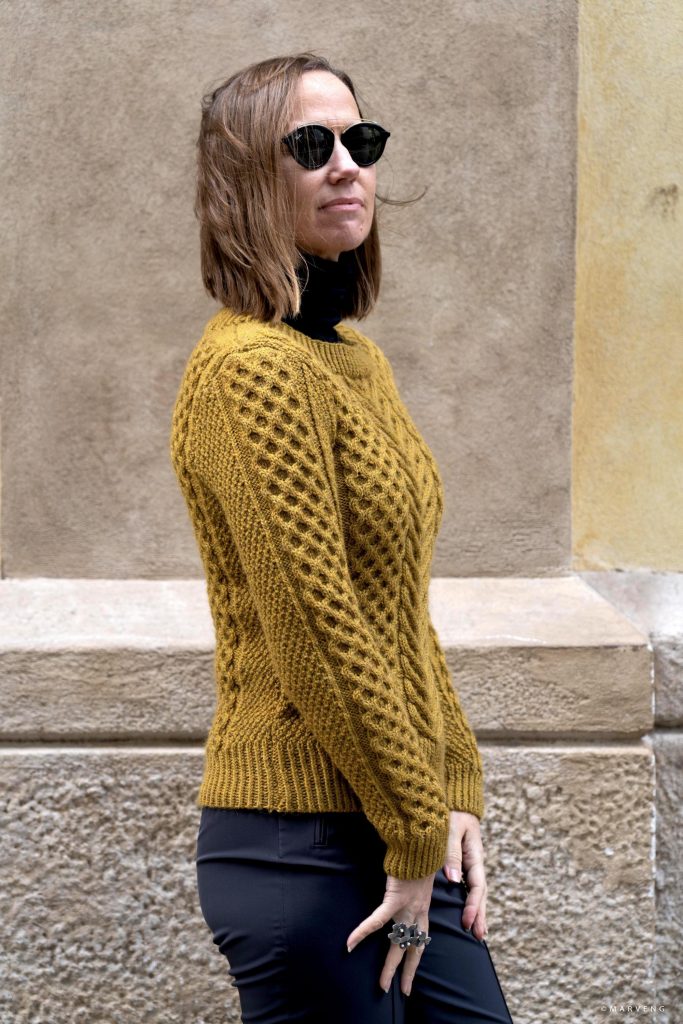 I had the idea for a fitted pullover with Honeycomb and stag horn cable, so I sent a yarn support request to The Fibre Co. which they approved. I knitted the pullover back and forth in separate pieces and crocheted it together. The sample is knitted in size Small, measuring 92 cm/36.25″ and in these photos taken by Michael in Barcelona you can see me wearing it with 4 cm/1.5″ positive ease. I have graded the pattern in sizes XS to 3XL, with a bust & hip circumference of 84 to 132 cm/33 to 52″.
I had the idea for a fitted pullover with Honeycomb and stag horn cable, so I sent a yarn support request to The Fibre Co. which they approved. I knitted the pullover back and forth in separate pieces and crocheted it together. The sample is knitted in size Small, measuring 92 cm/36.25″ and in these photos taken by Michael in Barcelona you can see me wearing it with 4 cm/1.5″ positive ease. I have graded the pattern in sizes XS to 3XL, with a bust & hip circumference of 84 to 132 cm/33 to 52″.
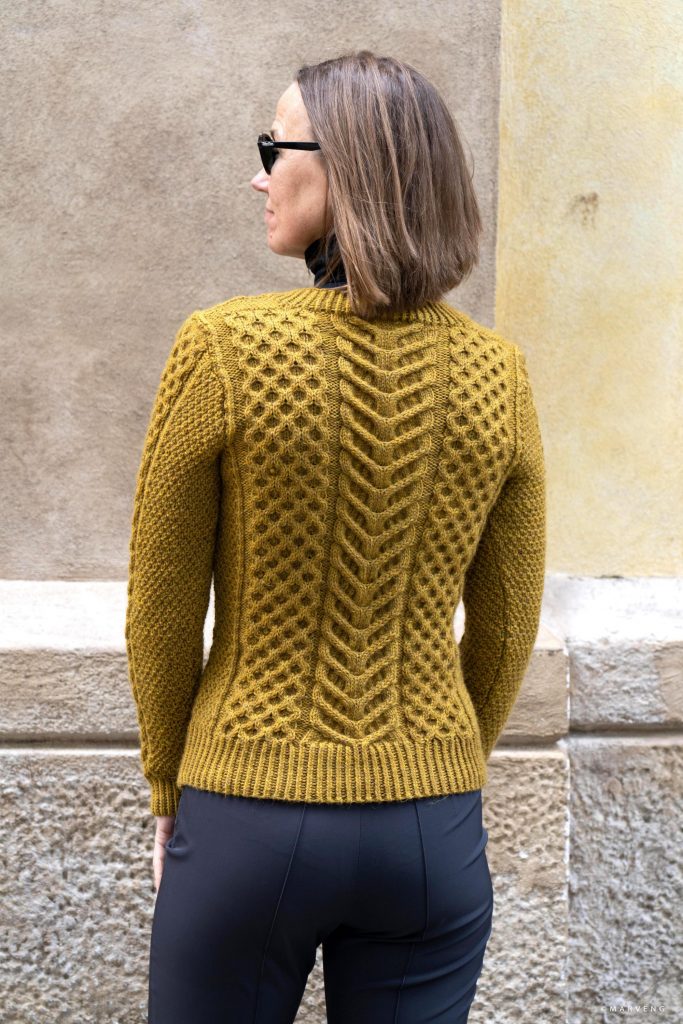 The Fibre Co. Cumbria is made of 60% merino wool, 30% masham wool, 10% mohair and comes in 100 gram skeins with 218 meters/238 yards. I knitted it with the gauge of 20 stitches and 28 rows in stockinette stitch using 4 mm/US 6 measures 10 cm/4″ square.
The Fibre Co. Cumbria is made of 60% merino wool, 30% masham wool, 10% mohair and comes in 100 gram skeins with 218 meters/238 yards. I knitted it with the gauge of 20 stitches and 28 rows in stockinette stitch using 4 mm/US 6 measures 10 cm/4″ square.
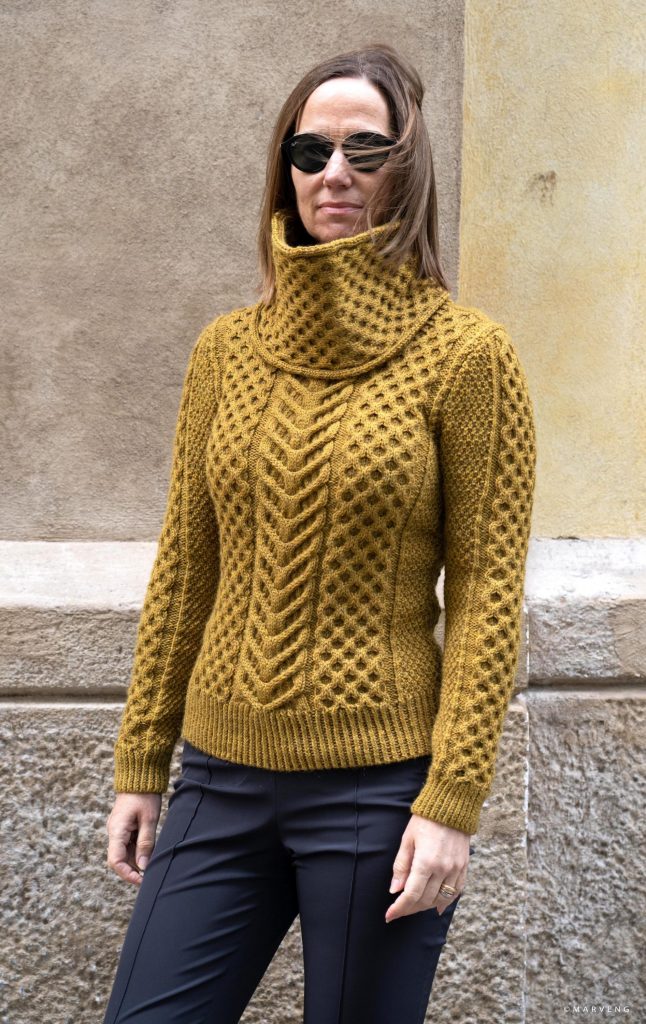 I also wanted a large cowl to go with the pullover. Especially since I could not decide want collar I wanted for the pullover.
I also wanted a large cowl to go with the pullover. Especially since I could not decide want collar I wanted for the pullover.
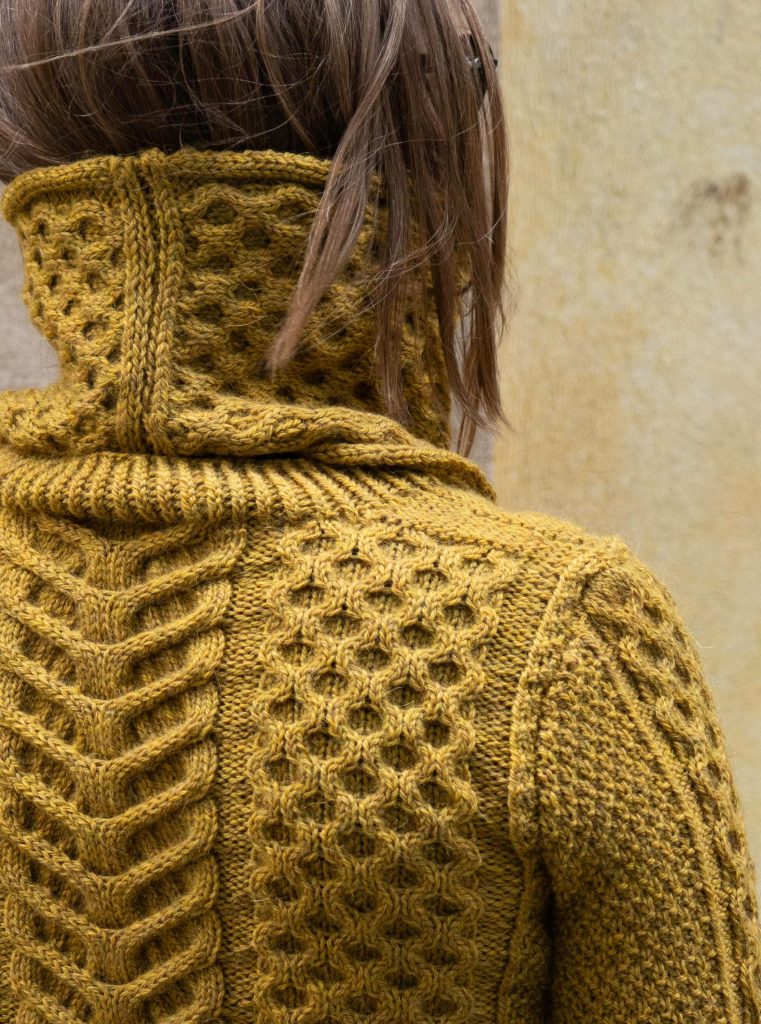 Before I release the English pattern of Grian I will have a test knit in my Ravelry group, beginning on the 20th of April. I look forward to showing you the photos Eivind Røhne took of this pullover worn by Olivia Lindtein.
Before I release the English pattern of Grian I will have a test knit in my Ravelry group, beginning on the 20th of April. I look forward to showing you the photos Eivind Røhne took of this pullover worn by Olivia Lindtein.
Høststrikk 2019 with Rørbye Cardigan and Nemetona
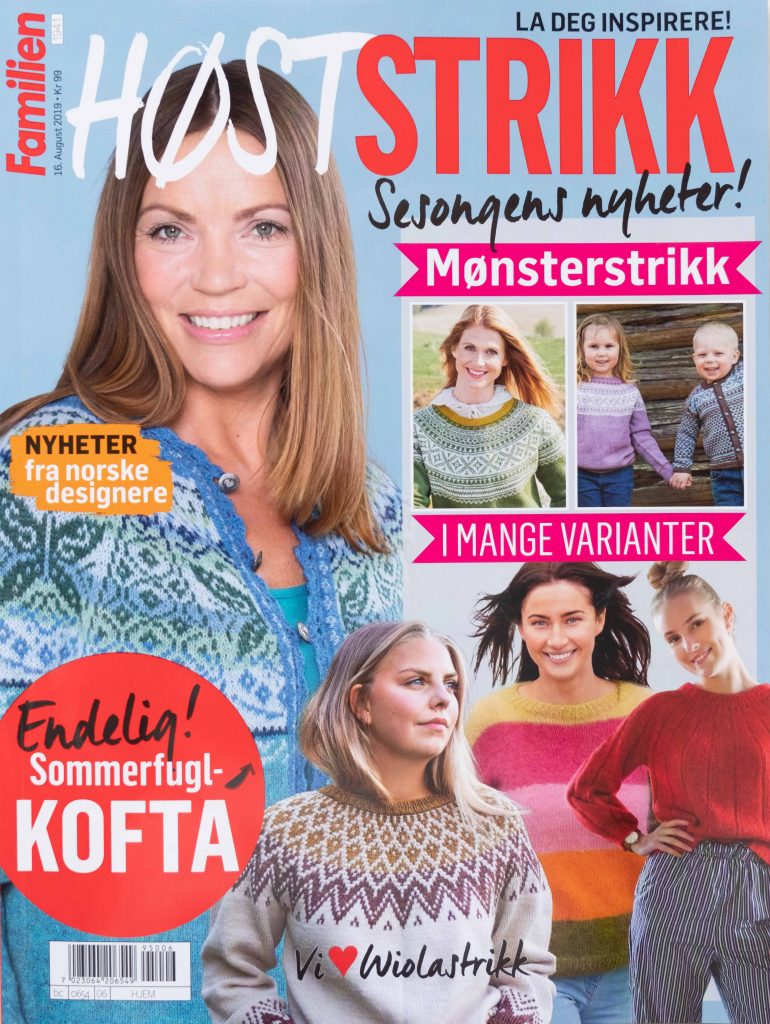 The Norwegian special magazine Høststrikk/Autumn Knits published by Familien is on sale and I am delighted to have two patterns inside it: Rørbye Cardigan and Nemetona. The magazines is filled with knitting patterns for all ages, but mainly for women as you can see from the cover. My Rørbye Cardigan modelled by Emma Ross, with hair & make up by Sissel Fylling and jewellery by Kaja Gjedebo Design, photographed by Eivind Røhne at the Vigeland Museum, is one of four designs on the back cover as well as on the editorial page.
The Norwegian special magazine Høststrikk/Autumn Knits published by Familien is on sale and I am delighted to have two patterns inside it: Rørbye Cardigan and Nemetona. The magazines is filled with knitting patterns for all ages, but mainly for women as you can see from the cover. My Rørbye Cardigan modelled by Emma Ross, with hair & make up by Sissel Fylling and jewellery by Kaja Gjedebo Design, photographed by Eivind Røhne at the Vigeland Museum, is one of four designs on the back cover as well as on the editorial page.
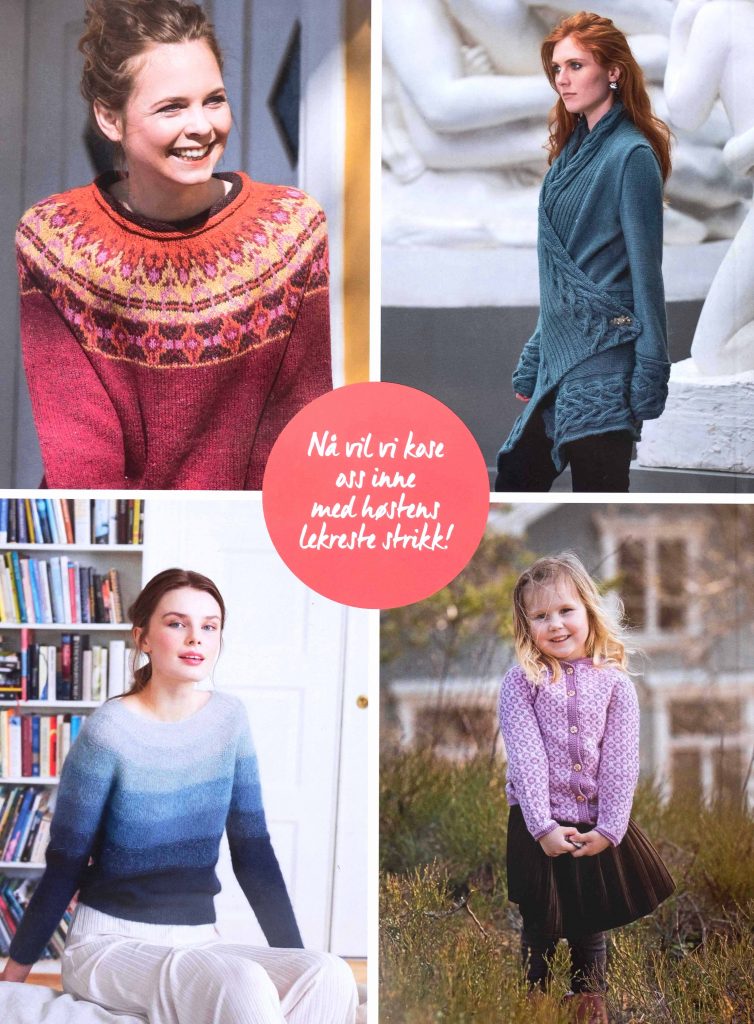 Here is the back cover, with the Rørbye Cardigan at the top, next to a design by Golden Days by Kari Hestnes. The jacket was made for Interweave knit.wear Fall/Winter 2017 and is knitted in Dale Eco Wool using 4 mm/US 6 needles. Here is my introduction: A classy and sophisticated knitted cardigan in a contemporary style. The waterfall bottom is created by knitting a sideways cable panel. To offset the cables, the body is all in stockinette stitch, with the exception of the cuff. Each sleeve begins in a sideways knitted cable panel. Leave it open, or pin the cardigan together at the front or in the side, if you prefer to wrap it all around you.
Here is the back cover, with the Rørbye Cardigan at the top, next to a design by Golden Days by Kari Hestnes. The jacket was made for Interweave knit.wear Fall/Winter 2017 and is knitted in Dale Eco Wool using 4 mm/US 6 needles. Here is my introduction: A classy and sophisticated knitted cardigan in a contemporary style. The waterfall bottom is created by knitting a sideways cable panel. To offset the cables, the body is all in stockinette stitch, with the exception of the cuff. Each sleeve begins in a sideways knitted cable panel. Leave it open, or pin the cardigan together at the front or in the side, if you prefer to wrap it all around you.
 Nemetona is featured inside the magazine at the beginning of my pages called “Fantastic Cables”. I do love the introduction: “Designer Linda Marveng is an expert on cable knitting. Here are two gorgeous designs photo grated on Emma Ross at the Vigeland Museum in Oslo.”
Nemetona is featured inside the magazine at the beginning of my pages called “Fantastic Cables”. I do love the introduction: “Designer Linda Marveng is an expert on cable knitting. Here are two gorgeous designs photo grated on Emma Ross at the Vigeland Museum in Oslo.”
 Nemetona is Celtic for goddess of all sacred places. Like a magical cable grove is each part of this pullover: Staghorn, Roman; and double cables are framed by Honeycomb pattern. The flowing longer back with its curved hem, creates a stylish contrast to the straight front. Nemetona is knitted in pieces in the divine The Fibre Co. Cumbria.
Nemetona is Celtic for goddess of all sacred places. Like a magical cable grove is each part of this pullover: Staghorn, Roman; and double cables are framed by Honeycomb pattern. The flowing longer back with its curved hem, creates a stylish contrast to the straight front. Nemetona is knitted in pieces in the divine The Fibre Co. Cumbria.
The Familien Høststrikk magazine is available at selected news agents and super markets. If you are in Norway you can buy a digital version for iPad, see www.klikk.no. If you live abroad you can order the Norwegian special magazine by e-mailing kari.bachke@egmont.com and then transfer payment into their bank account.
Eira Pullover and White Mountain Ruana in Vårens Strikk
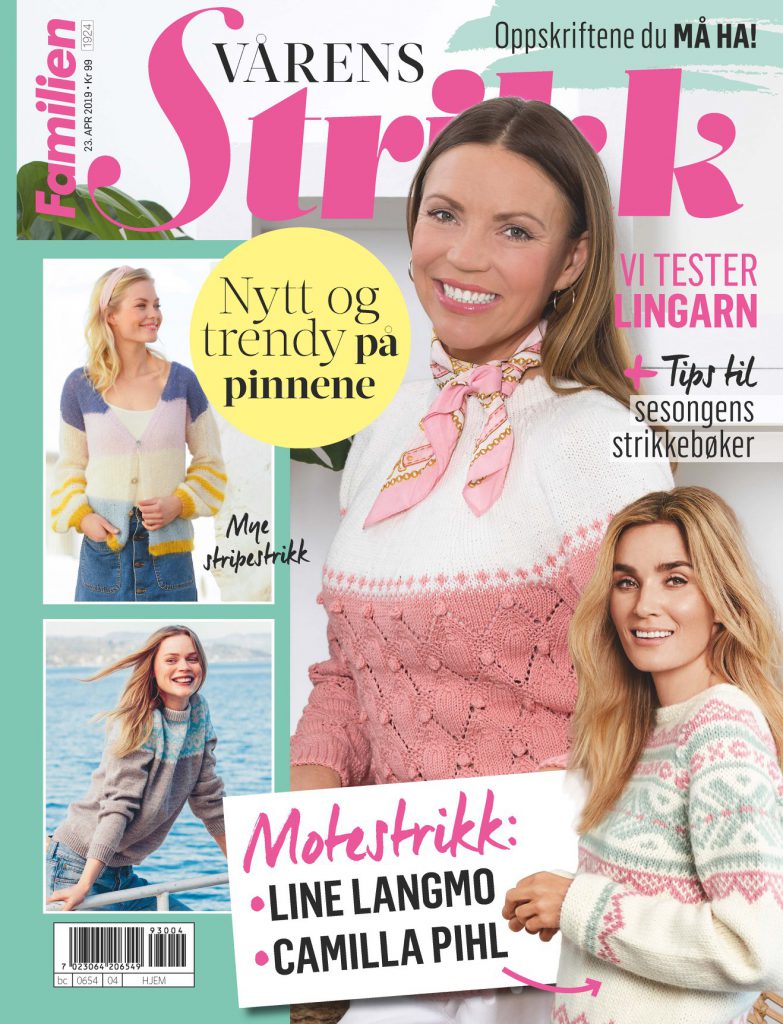 Vårens Strikk/Spring Knits is a special knitting issue published by the bimonthly magazine Familien in Norway released yesterday. I am delighted to have two designs: Eira Pullover and White Mountain Ruana as well as a brief interview in this magazine. Eira Pullover was made for knit.wear Fall/Winter 2017 and knitted in the lovely The Fibre Co. Cumbria using 4 mm/US 6 needles, while the White Mountain Ruana was made for Interweave Knits Winter 2018, knitted in the divine Shibui Knits, Maai using 4 mm/US 6 needles. Both designs were photographed for the second time around worn by the gorgeous Emma Ross, with hair & make up by Sissel Fylling and jewellery by Kaja Gjedebo Design, this time by Eivind Røhne at the Vigeland Museum in November 2018.
Vårens Strikk/Spring Knits is a special knitting issue published by the bimonthly magazine Familien in Norway released yesterday. I am delighted to have two designs: Eira Pullover and White Mountain Ruana as well as a brief interview in this magazine. Eira Pullover was made for knit.wear Fall/Winter 2017 and knitted in the lovely The Fibre Co. Cumbria using 4 mm/US 6 needles, while the White Mountain Ruana was made for Interweave Knits Winter 2018, knitted in the divine Shibui Knits, Maai using 4 mm/US 6 needles. Both designs were photographed for the second time around worn by the gorgeous Emma Ross, with hair & make up by Sissel Fylling and jewellery by Kaja Gjedebo Design, this time by Eivind Røhne at the Vigeland Museum in November 2018.
 The heading is a play on the word “flette” meaning cable in Norwegian, joined with the word “fin” meaning beautiful. Feminine garments with exciting cables is the introduction to the two patterns. The picture text is a short version of my introduction to Eira Pullover: A visually striking center cable named Kanik which is Eskimo for snowflake, adorns the center front and back on this pullover with saddle shoulders.
The heading is a play on the word “flette” meaning cable in Norwegian, joined with the word “fin” meaning beautiful. Feminine garments with exciting cables is the introduction to the two patterns. The picture text is a short version of my introduction to Eira Pullover: A visually striking center cable named Kanik which is Eskimo for snowflake, adorns the center front and back on this pullover with saddle shoulders.
 Here is the White Mountain Ruana, with part of the pattern text in Norwegian. My pages cover a total of 6 page in this special magazine which has a total of 100 pages with patterns for mainly women but also a few for men, children and babies.
Here is the White Mountain Ruana, with part of the pattern text in Norwegian. My pages cover a total of 6 page in this special magazine which has a total of 100 pages with patterns for mainly women but also a few for men, children and babies.
 The handcraft editor Åse Myhrvold Egeland, sent me a number of questions about my life in stitches such as what is your favourite pattern. I replied: “It is a difficult question. Just now, it is cables designed by the Polish designer Dorota Kowalczyk, aka devorgilla on Ravelry. I have used one of those on Corra, designed for Hillesvåg Ullvarefabrikk and their Tinde Pelsull, which is currently being test knitted”. Åse also wanted a number of photos not only of Em but also of me, so I sent her a small selection she could choose from. Michael is pleased to have his name as a photographer in the magazine. I am wearing Ataraxia, the sample I made that had to be re-knitted since the colour did not fit in together with the other designs in Pom Pom Quarterly Winter 2018 magazine. On the next page you see me wearing the dress Sigyn designed for Hillesvåg Ullvarefabrikk.
The handcraft editor Åse Myhrvold Egeland, sent me a number of questions about my life in stitches such as what is your favourite pattern. I replied: “It is a difficult question. Just now, it is cables designed by the Polish designer Dorota Kowalczyk, aka devorgilla on Ravelry. I have used one of those on Corra, designed for Hillesvåg Ullvarefabrikk and their Tinde Pelsull, which is currently being test knitted”. Åse also wanted a number of photos not only of Em but also of me, so I sent her a small selection she could choose from. Michael is pleased to have his name as a photographer in the magazine. I am wearing Ataraxia, the sample I made that had to be re-knitted since the colour did not fit in together with the other designs in Pom Pom Quarterly Winter 2018 magazine. On the next page you see me wearing the dress Sigyn designed for Hillesvåg Ullvarefabrikk.
 This special issue is for sale in newsagents and in selected super markets in Norway. If you live abroad you can order the Norwegian special magazine by e-mailing kari.bachke@egmont.com and then transfer payment into their bank account.
This special issue is for sale in newsagents and in selected super markets in Norway. If you live abroad you can order the Norwegian special magazine by e-mailing kari.bachke@egmont.com and then transfer payment into their bank account.
Photoshoot at Vigeland Museum: Eira Pullover
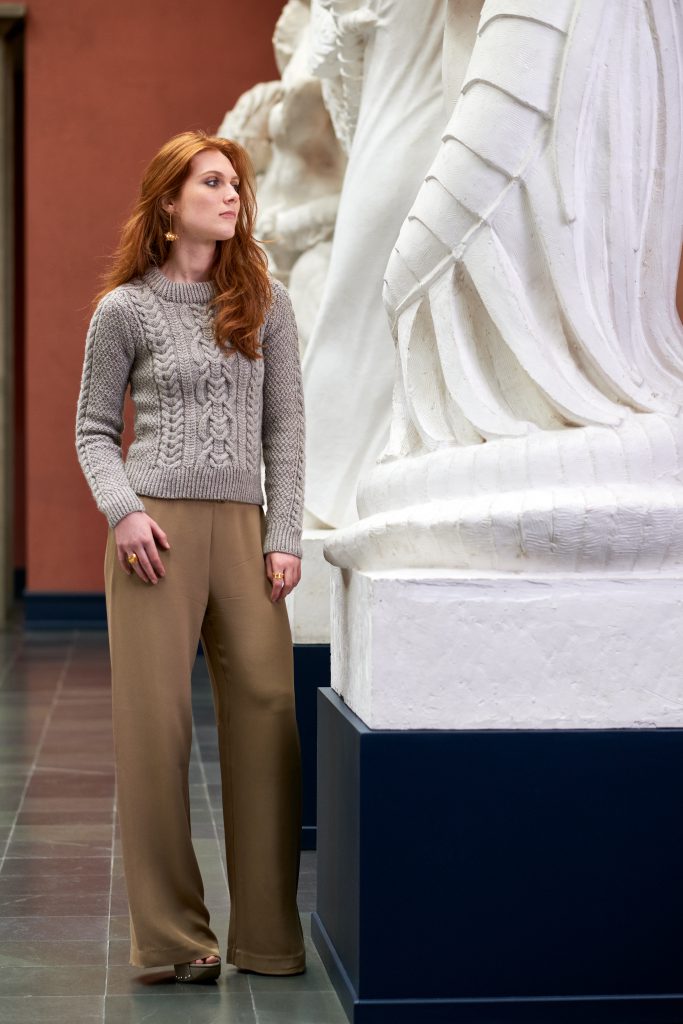 I have been looking forward to showing you more of the photos Eivind Røhne took at the Vigeland Museum in November last year. Out next is Eira Pullover, made for knit.wear Fall/Winter 2017, knitted in the divine The Fibre Co. Cumbria. Just like Nemetona, due to its light colour, I wanted to photograph this in Hall 9 with the huge plaster sculptures for the bridge in the Vigeland Park made by Gustav Vigeland in the background. Here is the gorgeous model Emma Ross, with hair & makeup by Sissel Fylling and jewellery by Kaja Gjedebo Design wearing the Eira Pullover. You can see the full sculpture in Michael’s photo in the Behind the Scenes: Photoshoot at Vigeland Museum blogpost.
I have been looking forward to showing you more of the photos Eivind Røhne took at the Vigeland Museum in November last year. Out next is Eira Pullover, made for knit.wear Fall/Winter 2017, knitted in the divine The Fibre Co. Cumbria. Just like Nemetona, due to its light colour, I wanted to photograph this in Hall 9 with the huge plaster sculptures for the bridge in the Vigeland Park made by Gustav Vigeland in the background. Here is the gorgeous model Emma Ross, with hair & makeup by Sissel Fylling and jewellery by Kaja Gjedebo Design wearing the Eira Pullover. You can see the full sculpture in Michael’s photo in the Behind the Scenes: Photoshoot at Vigeland Museum blogpost.
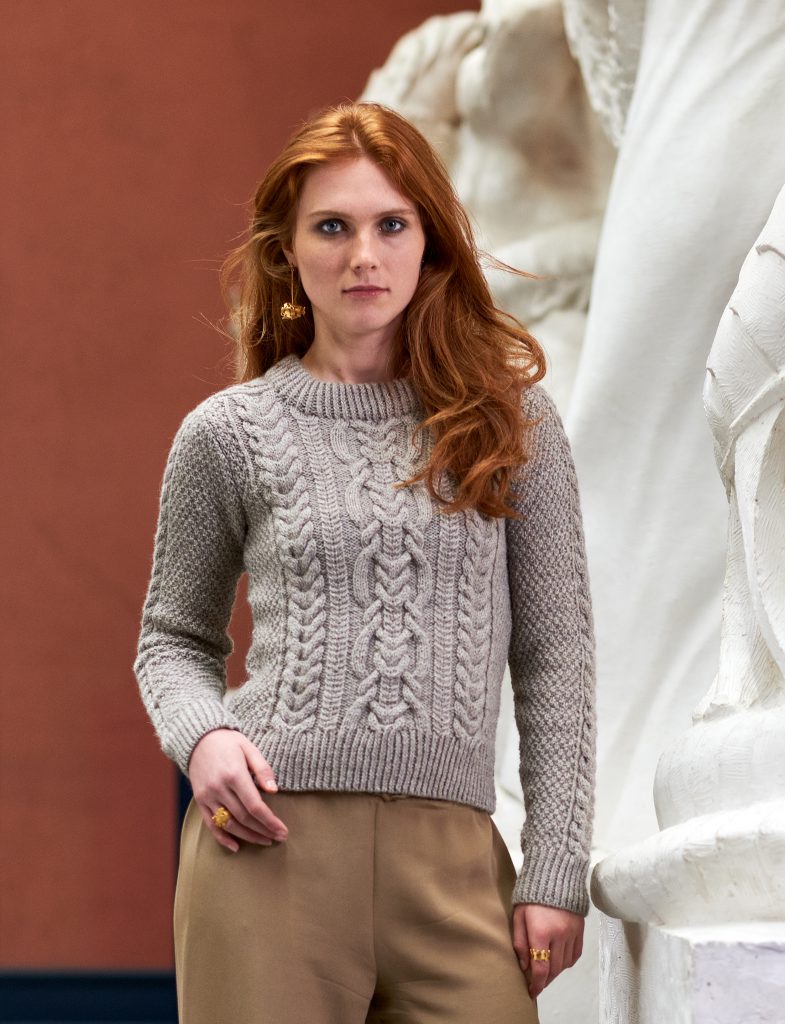 Here is my introduction to the Eira Pullover: A visually striking center cable named Kanik – Eskimo for snowflake – adorns the center front and back of this straight pullover. Kanik is framed by a staghorn cable on each side, while Moss stitch fills the background in the sides to allow the cables to shine. A saddle shoulder allows the staghorn sleeve cable to continue all the way to the neck.
Here is my introduction to the Eira Pullover: A visually striking center cable named Kanik – Eskimo for snowflake – adorns the center front and back of this straight pullover. Kanik is framed by a staghorn cable on each side, while Moss stitch fills the background in the sides to allow the cables to shine. A saddle shoulder allows the staghorn sleeve cable to continue all the way to the neck.
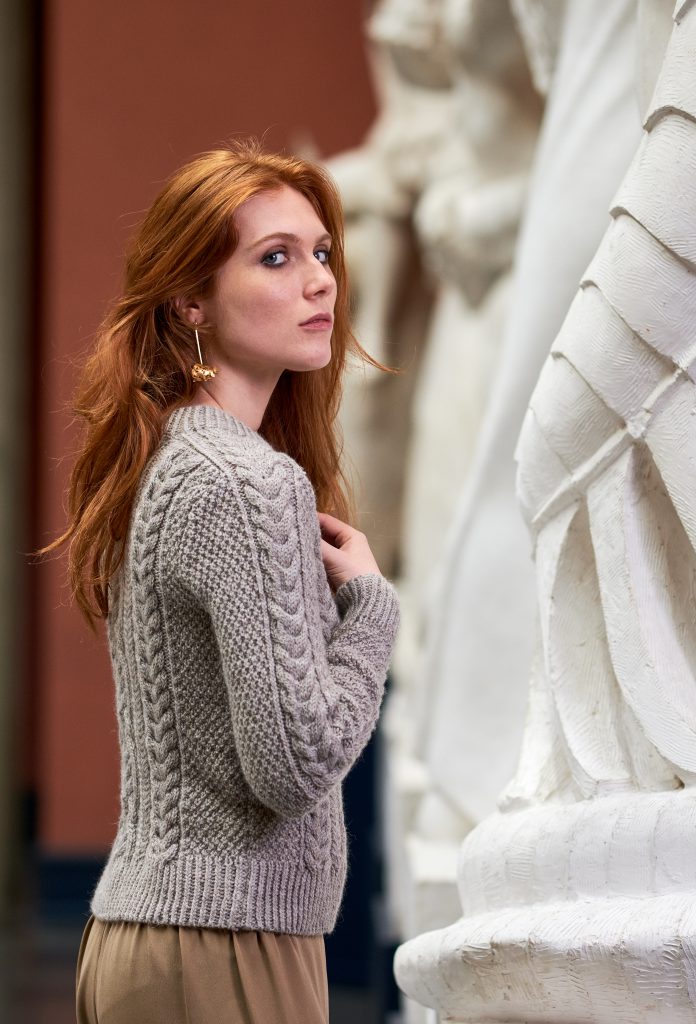 Em is wearing size XS, but the sweater is available in sizes XS to 2XL with a bust circumference of 81 to 123 cm/32 to 48.5″. I chose to style it with tan wide silk trouser after consulting with Sissel, whether to choose cream coloured ones or Judith Bech’s cream coloured skirt.
Em is wearing size XS, but the sweater is available in sizes XS to 2XL with a bust circumference of 81 to 123 cm/32 to 48.5″. I chose to style it with tan wide silk trouser after consulting with Sissel, whether to choose cream coloured ones or Judith Bech’s cream coloured skirt.
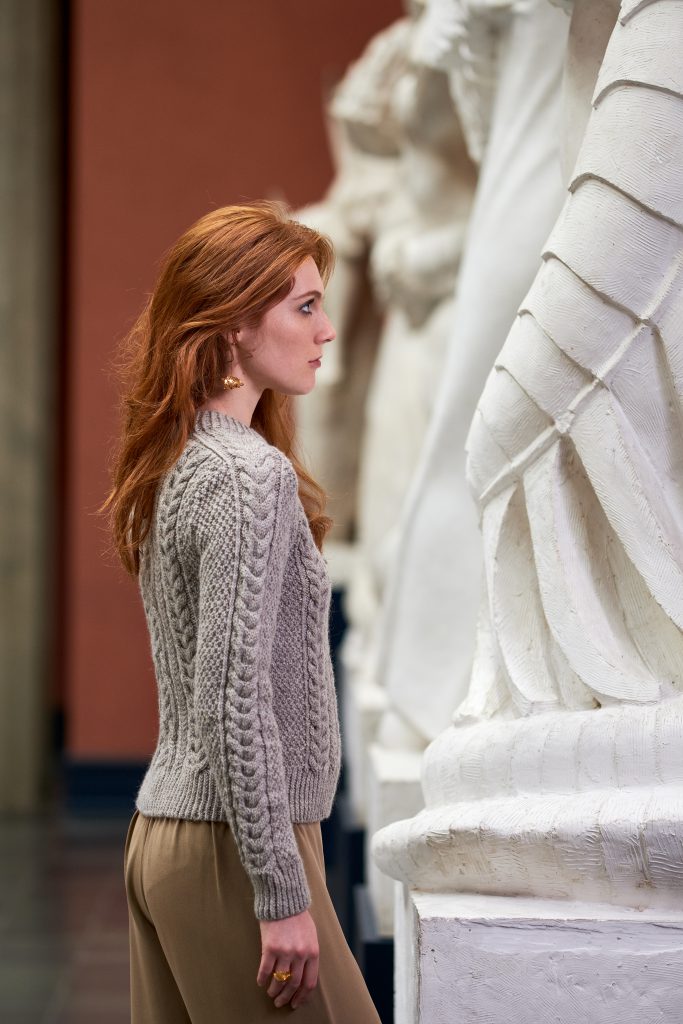 Eira Pullover is knitted in pieces in the divine The Fibre Co. Cumbria using 4 mm/US 6 needles with a gauge of 20 stitches and 28 rows in stockinette stitch measures 10 cm/4″ square. The Cumbria yarn is made of 60% merino wool, 30% brown masham wool, 10% mohair, on each 100 gram skein and has 218 meters/238 yards. I knitted the sample is in Scafell Pike and it takes 6 skeins of 100 grams to make size XS or about 1107 meters/1210 yards in a worsted or heavy DK weight yarn. I love how Em is studying the sculpture as well as how well you can see the cable on the sleeve in the photo above. Eivind and I also found this particular sculpture with the scales of the dragon such a fitting contrast to the cables.
Eira Pullover is knitted in pieces in the divine The Fibre Co. Cumbria using 4 mm/US 6 needles with a gauge of 20 stitches and 28 rows in stockinette stitch measures 10 cm/4″ square. The Cumbria yarn is made of 60% merino wool, 30% brown masham wool, 10% mohair, on each 100 gram skein and has 218 meters/238 yards. I knitted the sample is in Scafell Pike and it takes 6 skeins of 100 grams to make size XS or about 1107 meters/1210 yards in a worsted or heavy DK weight yarn. I love how Em is studying the sculpture as well as how well you can see the cable on the sleeve in the photo above. Eivind and I also found this particular sculpture with the scales of the dragon such a fitting contrast to the cables.
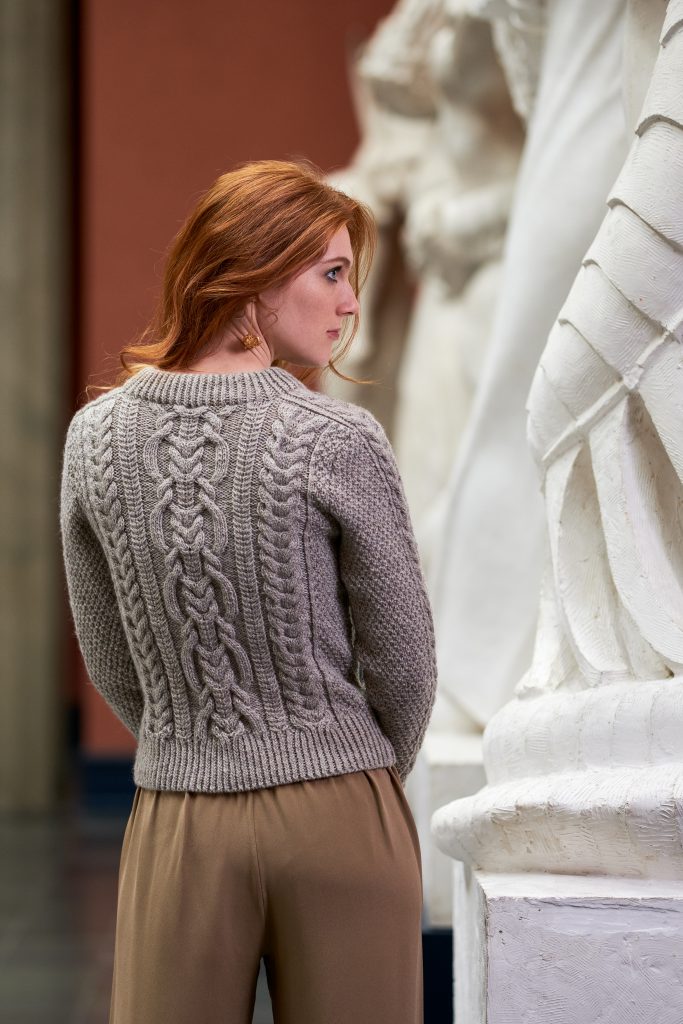 Last of the Eira Pullover photos is this one of the back. The English pattern is now available on Ravelry and on Loveknitting, as well as in the knit.wear magazine. This was the last one we photographed in Hall 9 at the Vigeland Museum, the remaining eight we photographed in the popular Monolith Hall. But I am sure we would have photographed some of those in the Fountain Hall, had it not been for the current exhibition of a contemporary artist showing an art piece we were not allowed to include in our photos, according to our contract. However, there were plenty of fantastic angles to use in the Monolith Hall. In my next blogpost from the Vigeland Museum Photoshoot I will tell you about another clause in our contract that Eivind liked to joke about. Thank you to my fantastic team! Next out is the Rørbye Cardigan.
Last of the Eira Pullover photos is this one of the back. The English pattern is now available on Ravelry and on Loveknitting, as well as in the knit.wear magazine. This was the last one we photographed in Hall 9 at the Vigeland Museum, the remaining eight we photographed in the popular Monolith Hall. But I am sure we would have photographed some of those in the Fountain Hall, had it not been for the current exhibition of a contemporary artist showing an art piece we were not allowed to include in our photos, according to our contract. However, there were plenty of fantastic angles to use in the Monolith Hall. In my next blogpost from the Vigeland Museum Photoshoot I will tell you about another clause in our contract that Eivind liked to joke about. Thank you to my fantastic team! Next out is the Rørbye Cardigan.
Photoshoot at Vigeland Museum: Nemetona
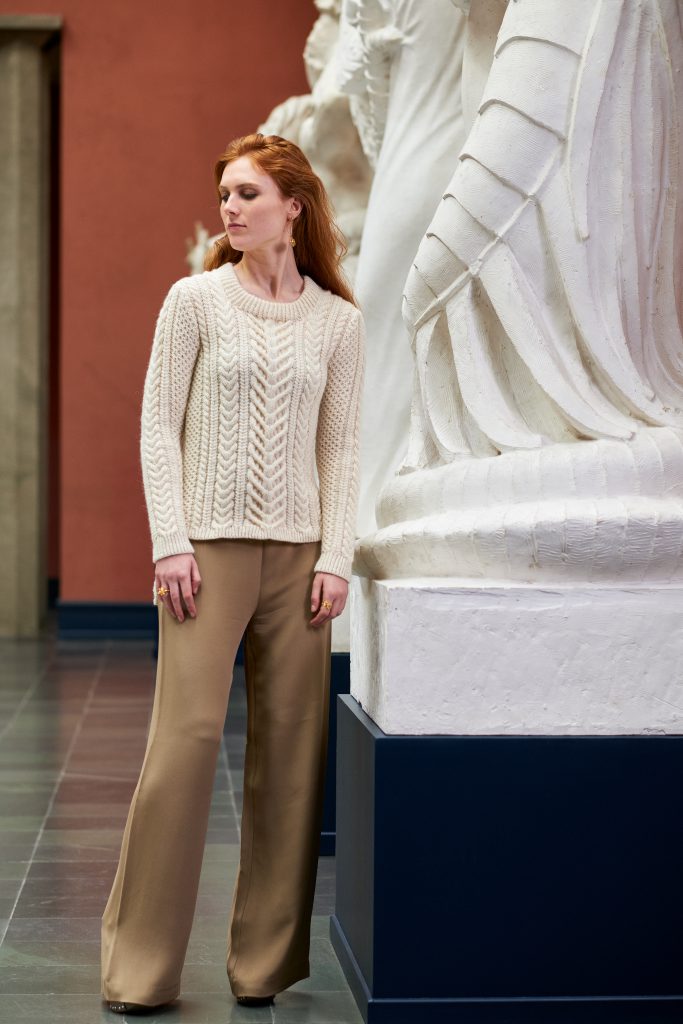 I have been looking forward to sharing the amazing photos Eivind Røhne took of gorgeous model Emma Ross, with hair & makeup by Sissel Fylling and jewellery by Kaja Gjedebo Design at the Vigeland Museum, next to the Vigeland Park in Oslo in November last year. The brick building in Norwegian Neo Classical style from the 1920’s does not look especially impressive from the outside, but I can promise you that the inside will blow you away. Not only because of all the sculptures but also because of the majestic ceiling height. “The museum is the result of a unique contract between Gustav Vigeland and the city of Oslo signed in 1921: The Municipality agreed to build a studio, residence and future museum for the artist and his work, and in return Vigeland donated nearly all his works, previous and future, to the city”. This year the Vigeland Museum celebrates that it is 150 years since the artist was born. What better occasion to start presenting these photos. First out is my new design Nemetona, since the test knit begins on Monday on Ravelry.
I have been looking forward to sharing the amazing photos Eivind Røhne took of gorgeous model Emma Ross, with hair & makeup by Sissel Fylling and jewellery by Kaja Gjedebo Design at the Vigeland Museum, next to the Vigeland Park in Oslo in November last year. The brick building in Norwegian Neo Classical style from the 1920’s does not look especially impressive from the outside, but I can promise you that the inside will blow you away. Not only because of all the sculptures but also because of the majestic ceiling height. “The museum is the result of a unique contract between Gustav Vigeland and the city of Oslo signed in 1921: The Municipality agreed to build a studio, residence and future museum for the artist and his work, and in return Vigeland donated nearly all his works, previous and future, to the city”. This year the Vigeland Museum celebrates that it is 150 years since the artist was born. What better occasion to start presenting these photos. First out is my new design Nemetona, since the test knit begins on Monday on Ravelry.
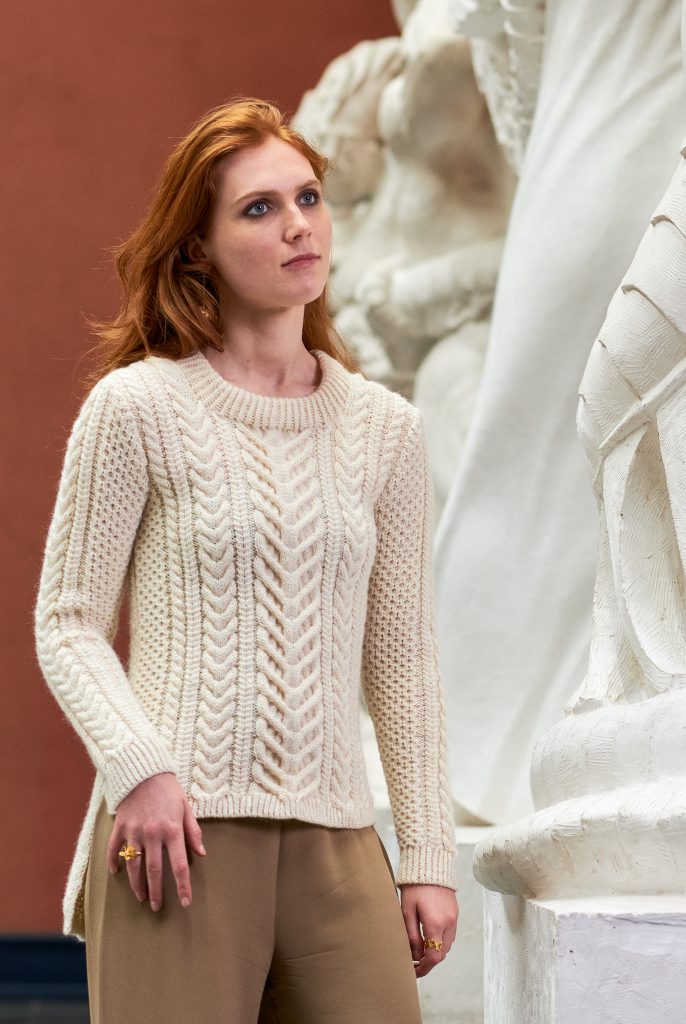 Nemetona is Celtic for goddess of all sacred places. Like a magical cable grove is each part of this pullover: Staghorn, Roman; and double cables are framed by Honeycomb pattern. The flowing longer back with its curved hem, creates a stylish contrast to the straight front. Nemetona is knitted in pieces in the divine The Fibre Co. Cumbria using 4 mm/US 6 needles and 3.5 mm/US 4 needles with a gauge of 20 stitches and 28 rows in stockinette stitch measures 10 cm/4″ square.
Nemetona is Celtic for goddess of all sacred places. Like a magical cable grove is each part of this pullover: Staghorn, Roman; and double cables are framed by Honeycomb pattern. The flowing longer back with its curved hem, creates a stylish contrast to the straight front. Nemetona is knitted in pieces in the divine The Fibre Co. Cumbria using 4 mm/US 6 needles and 3.5 mm/US 4 needles with a gauge of 20 stitches and 28 rows in stockinette stitch measures 10 cm/4″ square.
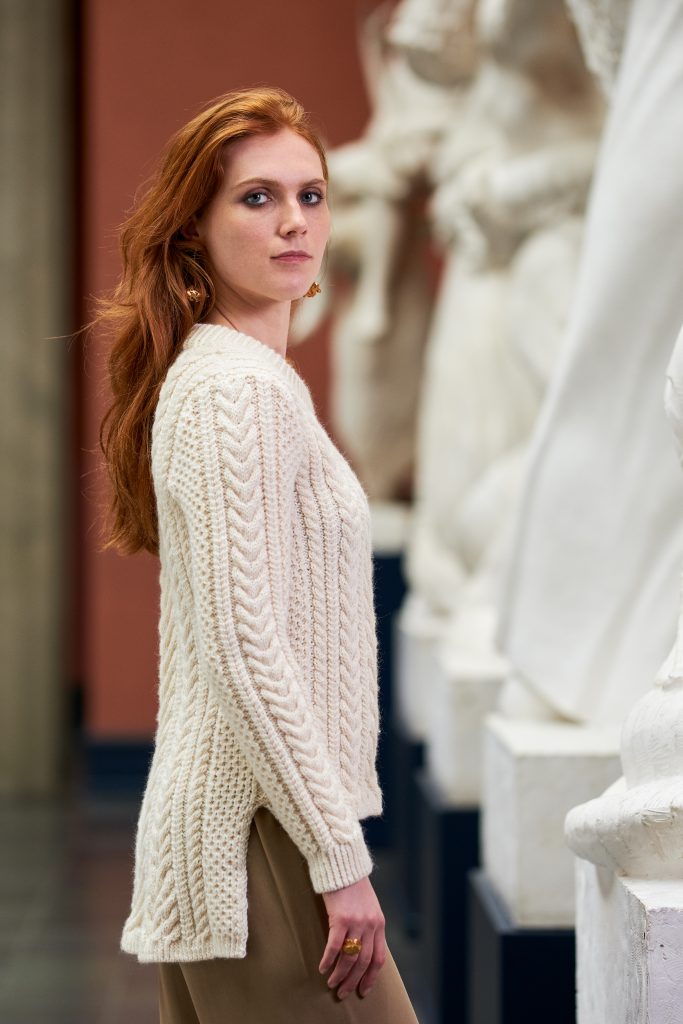 Em is wearing size small, while the pullover is graded from size XS to 2XL with a bust circumference of 84 to 126 cm/33 to 49.5″. I chose to style it with some tan coloured silk trousers, after asking for Sissel’s advice. In additon I had also brought the same trousers in cream and one of dress designer Judith Bech’s cream coloured long skirts with a train, because I had not made up my mind before we left for Oslo and the museum.
Em is wearing size small, while the pullover is graded from size XS to 2XL with a bust circumference of 84 to 126 cm/33 to 49.5″. I chose to style it with some tan coloured silk trousers, after asking for Sissel’s advice. In additon I had also brought the same trousers in cream and one of dress designer Judith Bech’s cream coloured long skirts with a train, because I had not made up my mind before we left for Oslo and the museum.
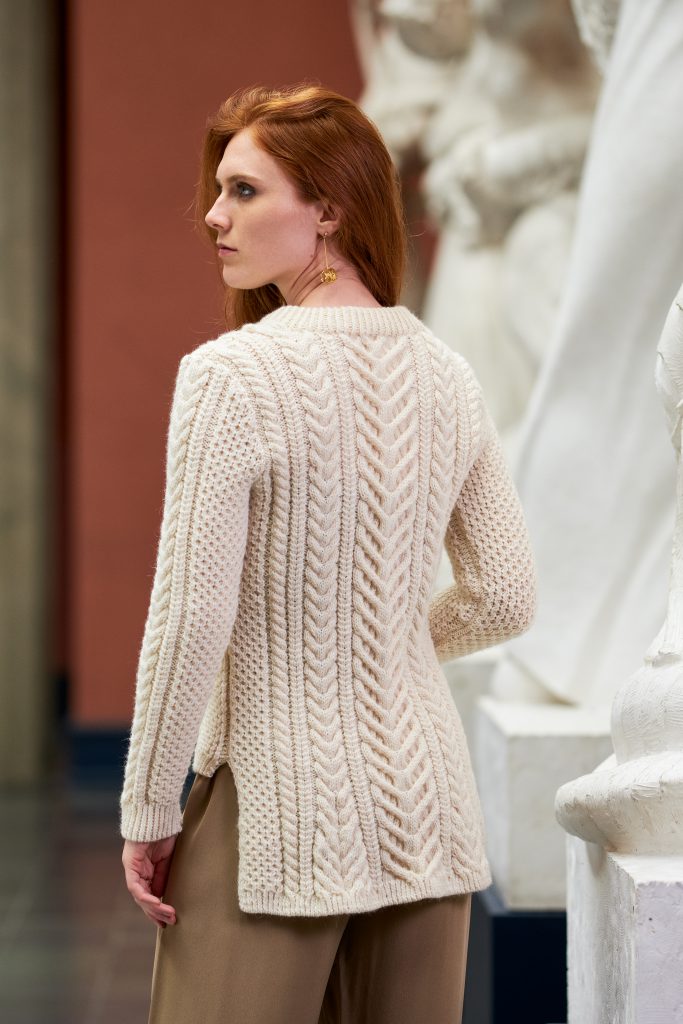 The sweater is knitted back and forth in pieces and then seamed. The neckband is worked in the round, double and folded down. The longer back has decreases in the double cable at the bottom. The vent edges are made with slipped stitches.
The sweater is knitted back and forth in pieces and then seamed. The neckband is worked in the round, double and folded down. The longer back has decreases in the double cable at the bottom. The vent edges are made with slipped stitches.
When the test knit of the English pattern is completed it will be released in my Ravelry store, while the Norwegian pattern will be published in the magazine Familien at a later date.
Nemetona was the second design (the other one was Eira Pullover) we photographed in Hall 9, with plaster models for the sculptures decorating the bridge in the Vigeland Park. You can see more of the sculptures in Michael’s photos in the Behind the Scenes: Photoshoot at Vigeland Museum blogpost. Both Eivind and I loved the massive, tall sculptures in this hall and the terracotta walls which we knew would suit Em’s hair colour. Above you see the results, thanks to my fantastic team!
Behind the Scenes: Photoshoot at Vigeland Museum
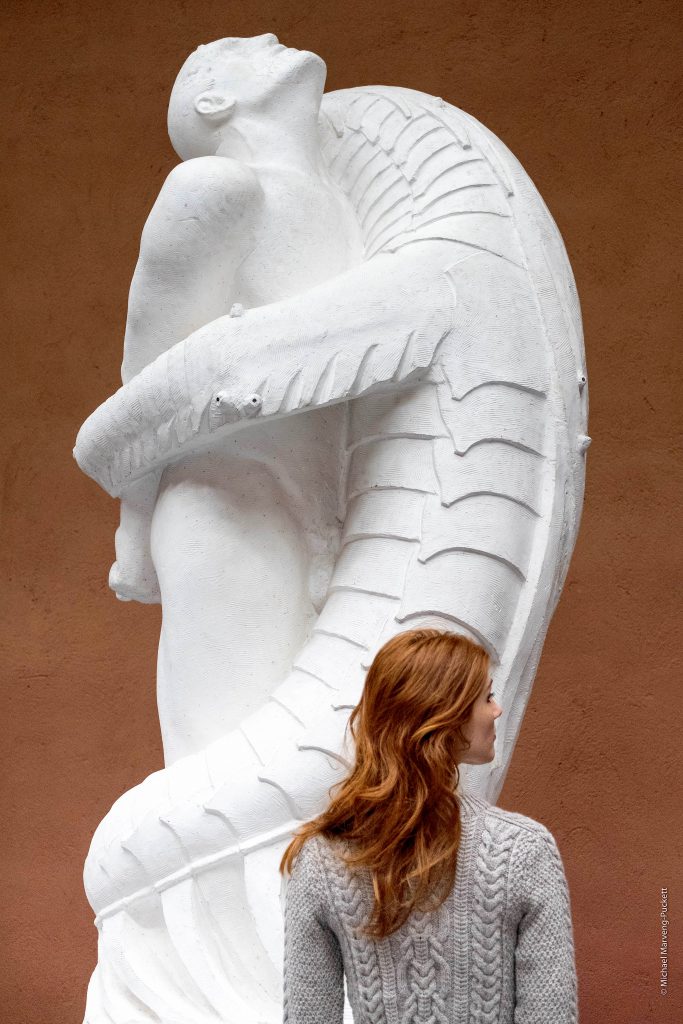 On Monday, I had a photoshoot at the Vigeland Museum, next to the Vigeland Park in Oslo. The brick building, with a majestic ceiling height, was built in the 1920’s in a Norwegian Neo Classical style. “The museum is the result of a unique contract between Gustav Vigeland and the city of Oslo signed in 1921: The Municipality agreed to build a studio, residence and future museum for the artist and his work, and in return Vigeland donated nearly all his works, previous and future, to the city”. It was with anticipation we (read my brilliant team: Photographer Eivind Røhne; Hair & Make Up Artist Sissel Fylling; Model Emma Ross; Michael; and me) were let in by one of the curators, as the museum is closed to the public on Mondays. During the day we had the chance to observe the curators at work and they us. As much as we admired their work, they enjoyed watching the beautiful garments being photographed and wondered which fashion magazine we were from. I explained that I designed handknit and that the photos were for the patterns and for the magazine Familien. Above you see gorgeous model Em, photographed by Michael in front of one of the plaster models for a sculpture to the park. Em is wearing Eira Pullover made for knit.wear Fall/Winter 2017, soon to be released in English in my Ravelry store.
On Monday, I had a photoshoot at the Vigeland Museum, next to the Vigeland Park in Oslo. The brick building, with a majestic ceiling height, was built in the 1920’s in a Norwegian Neo Classical style. “The museum is the result of a unique contract between Gustav Vigeland and the city of Oslo signed in 1921: The Municipality agreed to build a studio, residence and future museum for the artist and his work, and in return Vigeland donated nearly all his works, previous and future, to the city”. It was with anticipation we (read my brilliant team: Photographer Eivind Røhne; Hair & Make Up Artist Sissel Fylling; Model Emma Ross; Michael; and me) were let in by one of the curators, as the museum is closed to the public on Mondays. During the day we had the chance to observe the curators at work and they us. As much as we admired their work, they enjoyed watching the beautiful garments being photographed and wondered which fashion magazine we were from. I explained that I designed handknit and that the photos were for the patterns and for the magazine Familien. Above you see gorgeous model Em, photographed by Michael in front of one of the plaster models for a sculpture to the park. Em is wearing Eira Pullover made for knit.wear Fall/Winter 2017, soon to be released in English in my Ravelry store.
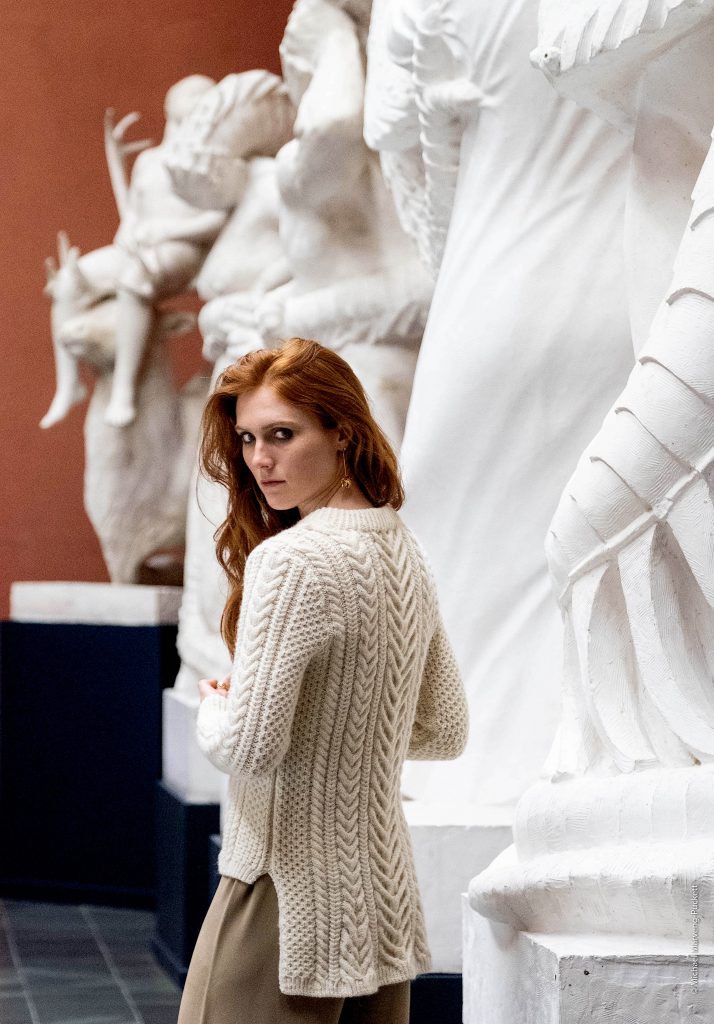 “Vigeland moved into the new building in 1924, living in the apartment on the top floor of the east wing. Here he resided and worked until his death in 1943. From the tower in this majestic red brick building he had a beautiful view towards the fields of Frogner, where his great project, the park, soon was to be reality.” We were guided into the Children’s room, were we would camp out all day. I am sure we enjoyed it as much as the children who usually visit that room! While Hair & Make up Artist Sissel was working her magic on Em, Eivind and I did a round in the museum. We picked two halls as for our shoot: Hall 9, which you see above and the Monolith Hall, which you see below. On the agenda was photographing a total of 10 garments: 4 new designs for Hillesvåg Ullvarefabrikk; 1 new design for the Norwegian magazine Familien: Nemetona; 4 returning designs from Interweave: Eira Pullover, Rørbye Cardigan, White Mountain Ruana and Andaman Top; 1 old design from my book: Tweedjakke with accessories: Duggdråpe Halser.
“Vigeland moved into the new building in 1924, living in the apartment on the top floor of the east wing. Here he resided and worked until his death in 1943. From the tower in this majestic red brick building he had a beautiful view towards the fields of Frogner, where his great project, the park, soon was to be reality.” We were guided into the Children’s room, were we would camp out all day. I am sure we enjoyed it as much as the children who usually visit that room! While Hair & Make up Artist Sissel was working her magic on Em, Eivind and I did a round in the museum. We picked two halls as for our shoot: Hall 9, which you see above and the Monolith Hall, which you see below. On the agenda was photographing a total of 10 garments: 4 new designs for Hillesvåg Ullvarefabrikk; 1 new design for the Norwegian magazine Familien: Nemetona; 4 returning designs from Interweave: Eira Pullover, Rørbye Cardigan, White Mountain Ruana and Andaman Top; 1 old design from my book: Tweedjakke with accessories: Duggdråpe Halser.
 “The museum opened in 1947, houses almost Vigeland’s entire production; sculptures in plaster, granite, bronze, marble, works in wrought iron, thousands of drawings, woodcuts and woodcarvings. In the museum you will find the original plasters to his famous busts and monuments, in addition to the plaster models to the sculptures in the Vigeland Park.” Above you can see Eivind in action, with me standing next to him and Michael just behind him. In the end we photographed nearly all of the garments, with the two exceptions you see above, in the Monolith Hall.
“The museum opened in 1947, houses almost Vigeland’s entire production; sculptures in plaster, granite, bronze, marble, works in wrought iron, thousands of drawings, woodcuts and woodcarvings. In the museum you will find the original plasters to his famous busts and monuments, in addition to the plaster models to the sculptures in the Vigeland Park.” Above you can see Eivind in action, with me standing next to him and Michael just behind him. In the end we photographed nearly all of the garments, with the two exceptions you see above, in the Monolith Hall.
The lizard in wrought iron is a model for the gates in the Vigeland Park and the most complicated of these wrought iron works Vigeland made. Their graphical presence added extra drama and was perfect for the Tweedjakke worn over Judith Bech’s wonderful skirt with a train. I was wearing the Patent Poncho, while Sissel – as you can see was cold – and wore her coat inside. To our surprise she did not cut Em’s hair this time. I had also borrowed jewellery by Kaja Gjedebo Design, as I usually do. There is no café at the museum so I had ordered catering from the nearby Eckers Cafe, with one delivery of drinks in the morning and one for lunch, so that we would not loose too much time looking for a nearby restaurant and wait for our lunch. That worked well and while we spent quite a bit of time to set up and prepare for the first garment, the remaining ones went quickly.
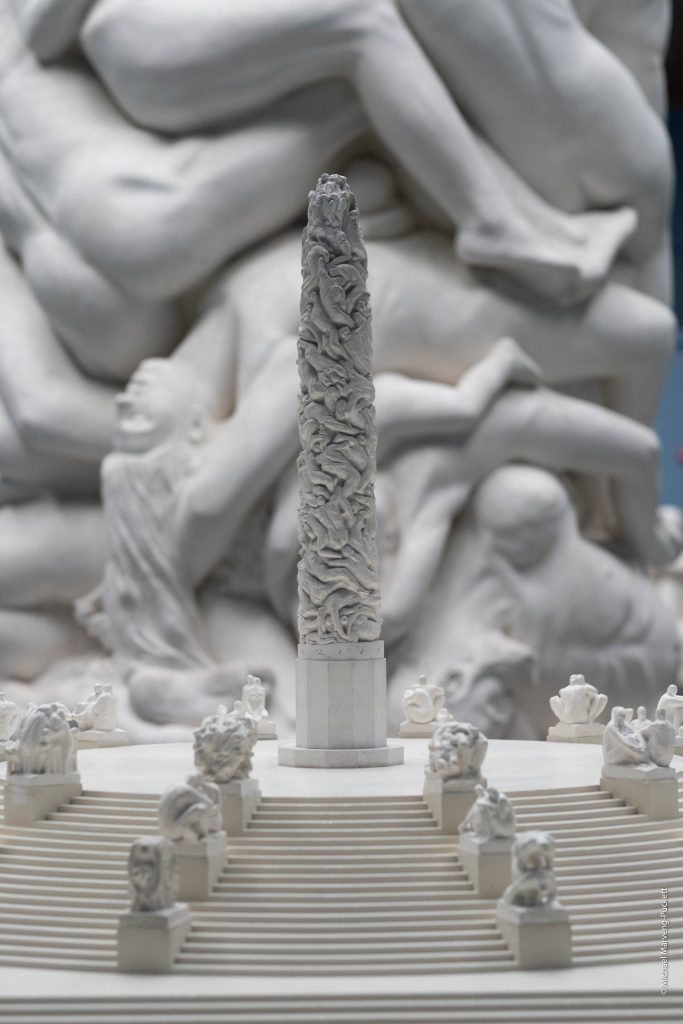 Michael assisted Eivind but also had the time to photograph some of the collection in the museum. Eivind had brought both extra lighting and a huge flash to make sure the lighting would be good enough. Above is the Monolith model for the park in front of the Monolith itself. “In the Monolith Hall stand several of the original plaster models to the 36 granite sculptures on the Monolith plateau, as well as the Monolith itself. This sculpture was carved in one piece (hence the name Monolith), but it was first modelled in clay, and then casted in plaster in three parts, as displayed in the museum today.”
Michael assisted Eivind but also had the time to photograph some of the collection in the museum. Eivind had brought both extra lighting and a huge flash to make sure the lighting would be good enough. Above is the Monolith model for the park in front of the Monolith itself. “In the Monolith Hall stand several of the original plaster models to the 36 granite sculptures on the Monolith plateau, as well as the Monolith itself. This sculpture was carved in one piece (hence the name Monolith), but it was first modelled in clay, and then casted in plaster in three parts, as displayed in the museum today.”
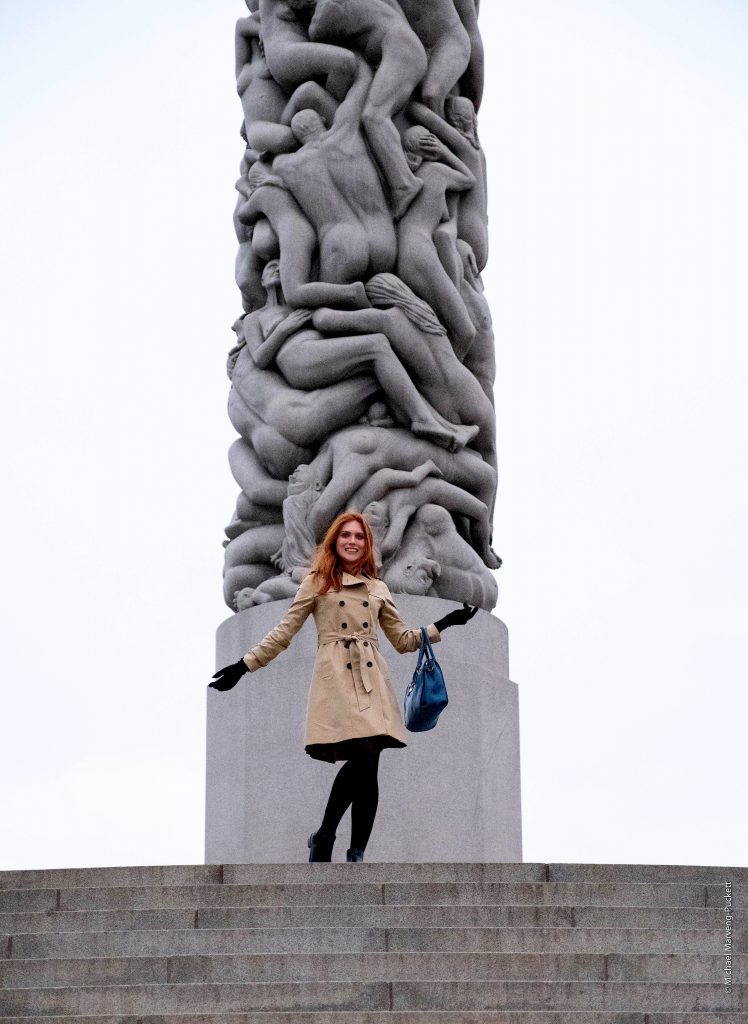 The Vigeland Museum is a popular venue for fashion shows, but also for concerts outside in the courtyard during the summer. The photoshoot was exhausting but also extremely rewarding and wonderful at the same time! After the shoot was a wrap – thanks to a brilliant team – and we had taken farewell with the curators and the security officer, we headed for the park, as Em has not had the time previously to see it. Above you see here in front of the Monolith in granite. Do visit both the park and the museum, when in Oslo, they are worth it. I will recapture our visit by choosing pictures from Eivind.
The Vigeland Museum is a popular venue for fashion shows, but also for concerts outside in the courtyard during the summer. The photoshoot was exhausting but also extremely rewarding and wonderful at the same time! After the shoot was a wrap – thanks to a brilliant team – and we had taken farewell with the curators and the security officer, we headed for the park, as Em has not had the time previously to see it. Above you see here in front of the Monolith in granite. Do visit both the park and the museum, when in Oslo, they are worth it. I will recapture our visit by choosing pictures from Eivind.

